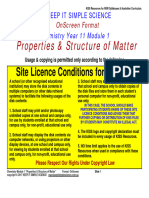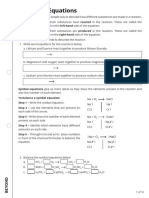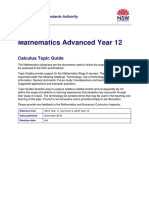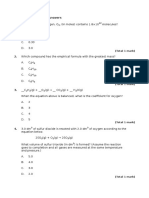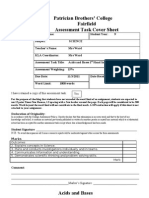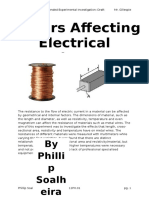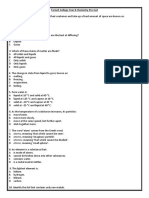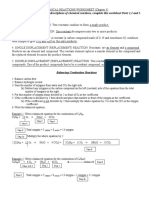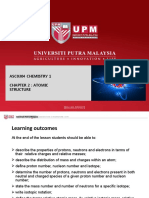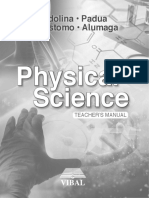Year 10 Chemistry Weekly Program
Year 10 Chemistry Weekly Program
Uploaded by
api-301274795Copyright:
Available Formats
Year 10 Chemistry Weekly Program
Year 10 Chemistry Weekly Program
Uploaded by
api-301274795Original Title
Copyright
Available Formats
Share this document
Did you find this document useful?
Is this content inappropriate?
Copyright:
Available Formats
Year 10 Chemistry Weekly Program
Year 10 Chemistry Weekly Program
Uploaded by
api-301274795Copyright:
Available Formats
Year 10 Semester 1- Chemistry
Week
Topic
Lessons
Resources
Periodic Table
Monday and Wednesday (2 lessons): Explain to students that the periodic
table is organised into 18 groups and 7 periods. Go through the ppt called
Elements and the periodic table.
PPt on
schoology and
work booklet
on schoology.
Student task: Complete the worksheet on colouring in the different groups.
Structure of an
atom, compounds,
elements and
mixtures
Friday lesson 3:
Go through the PowerPoint on schoology, students are to take notes down from
the ppt into their books.
Student task: Complete the worksheet on recognising a compound, element
or mixture, or molecule.
Making a class
periodic table and
Becoming an
element expert
Atomic Number,
Atomic mass,
protons, neutrons
and electrons.
Monday and Wednesday : (2 lessons)
All students choose an element and become an expert in that element. Create
a card that replicates the periodic table and label as many parts as possible.
Must contain element name, atomic number, symbol, group & period.
Find 5 fun facts about your element. Only do first 30 elements on the periodic
table
Plain paper
(half an A4
size),
coloured
pencils/ textas
Friday lesson 3:
Task 1: Students Copy the following information into your books.
Use puffin
Atomic number is the number of number of protons in the nucleus of app if the
an atom. It is listed on the periodic table for each element.
Scope an
Sequenc
(ACARA)
The atom
structure
propertie
used to o
them in t
Periodic T
(ACSSU18
Different
of chemic
reactions
used to p
a range o
products
can occu
different
(ACSSU18
Year 10 Semester 1- Chemistry
o For carbon the atomic number is 6 so the number of protons is also 6.
Atomic number is also the number of electrons in the atom (when
game will not
open.
the atom of the element has no charge).
o Carbon has 6 electrons when the atom has no charge.
Atomic mass is the number of protons + the number of neutrons.
Always remember to round the atomic mass to the nearest whole number.
o The atomic mass of carbon is 12.0107, which we would round to 12.
To find the number of neutrons in an atom of an element subtract the
atomic number from the atomic mass, round your answer to the nearest
whole number.
o Atomic mass (12) Atomic number (6) = 6
o So carbon has 6 neutrons.
Task 2: Complete the element math game
(http://education.jlab.org/elementmath/index.html)
Go to the above website
Select 20 questions and then click more options please
Select First 36 elements and then Im ready! Lets start!
You must score at least 90% in the quiz and take a screen shot of your
results
If you do not score at least 90% you need
3
How do we know a
chemical reaction
has taken place?
Alkali metals, noble
Monday lesson 1: Go through the ppt called chemical reactions. Students
take notes
Schoology
Wednesday lesson 2:
Practical experiment on observing reactions.
Completing full practical write up in their books to be handed in for marking
Practical
guidelines
schoology
Year 10 Semester 1- Chemistry
gases and halogens
in depth
The Bohr Model and
drawing structure of
elements
Types of chemical
reactions
Friday:
Students are to use the reading material called alkali metals, halogens and
noble gases (on schoology) to answer the worksheet. (photocopy from
worksheet booklet)
Monday lesson 1:
Go through the ppt prezo to explain the Bohr Model. Students take down
notes.
Show short video called atoms and trends of the periodic table Great video
to summarise topics so far. (on schoology)
Student task:
Provide students each with a blank copy of the Bohr model. Using beads
students are to create the structure of the first 20 elements. Once they have
created it on their card they are to draw each of the elements with labels into
their books.
Ppt on
schoology.
Blank Bohr
model (hard
drive) and
small beads.
Wednesday lesson 2:
Go through the PowerPoint to explain the types of chemical reactions. Students
take down notes from this.
Ppt schoology
Students are than to complete the virtual lab called chemical reactions virtual
lab (on schoology week 14)
Link on
schoology
page
Friday lesson 3:
Practical experiment on the types of chemical reactions (will take 2 lessons to
complete)
Practical
guidelines
Year 10 Semester 1- Chemistry
schoology
5
Monday lesson 1:
Finish off types of chemical reactions practical. Complete full practical write up
Catalysts and
inhibitors
Wednesday lesson 2:
Revision for chemistry exam, catch up on missed work
Friday lesson 3:
Chemistry exam. Provide students with exam booklet and calculator. No other
materials are allowed into the class room.
Metals, Non Metals
and Reactivity of
Metals
Revision
document
Exam Booklet
Monday lesson 1:
Look at PowerPoint called metals and non-metals. Students are to take notes
from this into their books. Than look at the PowerPoint called reactivity of
metals again students are to take down notes into their books. Watch the
short clip show how metals react in water. If time have students complete the
virtual lab and questions called reactivity of metals. Open the lab through
puffin to ensure it works.
PowerPoint
and resources
all on
schoology
Wednesday Lesson 2:
Students are to complete the virtual lab called metals and non- metals and
complete the questions into their books.
Link is on
schoology
Friday Lesson 3: (will take 2 lessons)
Students will complete a practical experiment in groups called Reactivity of
metals. Students need to write up in a full prac report into their books.
Experiment
on schoology
Year 10 Semester 1- Chemistry
Types of Bonding
(Ionic and
covalent(molecular))
Monday Lesson 1:
Finish off reactivity of metals practical
Wednesday Lesson 2:
You tube clips
Watch the below links on the two types of bonding. Stop the clips throughout
to for students to draw each diagram and notes.
http://www.youtube.com/watch?v=Qf07-8Jhhpc
http://www.youtube.com/watch?v=PKA4CZwbZWU
Write the following examples on the board and have students practice them in
their books.
Here are examples of ionic bonds and ionic compounds:
NaBr - sodium bromide
KBr - potassium bromide
NaCl - sodium chloride
NaF - sodium fluoride
KI - potassium iodide
KCl - potassium chloride
CaCl2 - calcium chloride
Examples of covalent bonding:
PCl3
CH3CH2OH
O3 - ozone
H2 - hydrogen
H2O - water
HCl - hydrogen chloride
CH4 - methane
NH3 - ammonia
CO2 - carbon dioxide
Year 10 Semester 1- Chemistry
Friday Lesson 3:
Balancing Equations
Lesson 1-Monday and lesson 2 -Wednesday
Write on board: (student notes)
- Write the correct chemical formula of all the reactants and products.
- Count the number of atoms of each type appearing on both sides.
- If the numbers on each side are not the same, place numbers in front of
the formula until they are. You may need to go back and forth a few
times until you get the numbers right.
- Do not change any of the formulas
- The number in front apply to all the symbols in the formula.
- Check to make sure the equation is balanced.
- Reactants must = the products
- Create a mini table as below to help
Reactants
Products
Once completed notes go through some examples on the board.
__ Fe + O2
> ____ Fe2 O3
Balancing
equations
worksheet
practice and
answer sheet
Year 10 Semester 1- Chemistry
___ C + ___ 02
>
C0
___ Na + ___ 02 > ___ Na20
____ C + ___ S8 > ____ CS2
___ N2 + ___ 02 > ___ N2O5
___ Al + ___ S8 > ___ Al2S3
Students are than to have a go at the worksheet individually. This may take
students two lessons to fully understand. If struggling go through more
examples and have students completed extra questions.
Lesson 3 Friday
Year 10 Semester 1- Chemistry
9
Factors that Affect
the Rate of
Reactions
Monday:
Go through power point called factors that Affect the rate of a reaction. Have
students copy down notes from these slides.
Rates of
reaction ppt
(schoology)
Summary Chart of Rates of Reaction also to be copied into books
Factor that
Affect on Rate
Examples
Molecular Level
Incr. Temp.
A log will ignite on a bed of Molecules are hit harder
Incr. Rate of
hot coals
affects Rate
of Reaction
Temperature
Reaction
Surface Area Incr. Surface Area
Concentration
Catalyst
Four dust will ignite near a Molecules are hit more
Incr. Rate of
flame, a pile of flour does
Reaction
not
often
Incr. Concentration Two antacid tablets
Molecules are hit more
Incr. Rate of
neutralize twice as much
often
Reaction
stomach acid as one does
Positive Catalyst
Liver enzymes incr.
Molecules have an easier
Incr. Rate of
chemical breakdown
way to react
Reaction
Student task:
Students complete rates of reaction worksheets
Wednesday- Lesson 2:
Practical experiment on how temperature can affect the rate of a reaction.
Have students write the practical in their books, create a hypothesis before
Rates of
reaction
worksheet
(schoology)
Year 10 Semester 1- Chemistry
conducting the practical.
Students are to record results in the table and then plot their results on the
graph paper on the worksheet.
Friday lesson 3: 2 x practical experiments
Practical = how surface area affects the rate of a reaction. (pg 131 textbook).
Graph results also.
Summarise the Power point into books called Factors that affect the rate of
reactions.
Experiment
guidelines
worksheet
(schoology)
Need to print
Experiment
guidelines
(schoology)
10
The chemistry in
pharmaceuticals, bio
fuels and fossil fuels
Monday Lesson 1:
Research Chemistry task:
Students are to investigate how chemistry can be used to produce a range of
useful substances
Choose one of the following:
Power point
on schoology.
Students
iPads and
workbooks.
Download the
app from
Appstore
Year 10 Semester 1- Chemistry
Fuels
Metals
Pharmaceuticals
Fireworks
Or something of your own choosing
Research what your substance is and the chemical processes involved in the
production of substance. Once finishing your research you are to present this
information in a mind map using the app called inspiration it is free. Upload
mind map to schoology for marking by the end of the lesson.
Wednesday lesson 2:
Friday lesson 3: Final lesson of term
called
inspiration
Year 10 Semester 1- Chemistry
You might also like
- c3 Revision WorksheetsDocument5 pagesc3 Revision Worksheetsapi-236179294No ratings yet
- Year 10 Chemistry Summary NotesDocument8 pagesYear 10 Chemistry Summary NotesBethanyLeiseNo ratings yet
- Chemistry Titration Assessment TaskDocument16 pagesChemistry Titration Assessment Taskapi-355358190100% (1)
- 2018 Year 9 Science ProgramDocument16 pages2018 Year 9 Science Programapi-364379734No ratings yet
- Chapter 2 - Atoms - Molecules - and IonsDocument53 pagesChapter 2 - Atoms - Molecules - and IonsWarakorn Akarasareenon100% (1)
- Year 10 Chemistry - Practice Exam Questions Rates and REversible ReactionsDocument4 pagesYear 10 Chemistry - Practice Exam Questions Rates and REversible ReactionsAshleyn Mary SandersNo ratings yet
- Year 11 Chemistry Revision BookletDocument4 pagesYear 11 Chemistry Revision BookletHakim Abbas Ali PhalasiyaNo ratings yet
- Chem Module 1 OnScreenDocument73 pagesChem Module 1 OnScreenLarah XeniaNo ratings yet
- Year 10 Biology Course OverviewDocument2 pagesYear 10 Biology Course Overviewapi-102850034No ratings yet
- Topic 1 Revision SACE ChemistryDocument15 pagesTopic 1 Revision SACE ChemistryMustafa RezaieNo ratings yet
- 2017 Qats Units 3 4Document31 pages2017 Qats Units 3 4kaustubhsontyNo ratings yet
- Yr 11 Chemistry Exam NotesDocument13 pagesYr 11 Chemistry Exam NotesadfknaljhNo ratings yet
- A Level Chemistry Edexcel Sample ChapterDocument38 pagesA Level Chemistry Edexcel Sample ChapterTeamonedirextionNo ratings yet
- HSC Preliminary Chemistry NotesDocument32 pagesHSC Preliminary Chemistry NotesHarvey Luo100% (1)
- 2004 Chemistry - James Ruse With SolutionsDocument36 pages2004 Chemistry - James Ruse With SolutionsWilliam HouNo ratings yet
- Physics: 2014 Australian Science Olympiads ExamDocument12 pagesPhysics: 2014 Australian Science Olympiads ExamAdewuyi IsraelNo ratings yet
- Chemistry Paper 3 SLDocument14 pagesChemistry Paper 3 SLamrdeck1No ratings yet
- Textbook Inc Ch1 5 2020 03 15Document452 pagesTextbook Inc Ch1 5 2020 03 15IAN IANIANIANIANNo ratings yet
- Flametest PDFDocument2 pagesFlametest PDFChecaina RistonNo ratings yet
- Year 9 Science NotesDocument7 pagesYear 9 Science NotesChenny Chen100% (1)
- Olympiad Support Booklet - Full Text 2Document60 pagesOlympiad Support Booklet - Full Text 2Popa ElenaNo ratings yet
- GCSE Quantitative Chemistry Home Learning SheetsDocument30 pagesGCSE Quantitative Chemistry Home Learning SheetsShaheer HashmiNo ratings yet
- Notes and Questions: Aqa GcseDocument18 pagesNotes and Questions: Aqa Gcseapi-422428700No ratings yet
- Igcse Combined Science: Paper 0653/01 Multiple ChoiceDocument20 pagesIgcse Combined Science: Paper 0653/01 Multiple Choiceseyka4No ratings yet
- 2008 James Ruse HSC Chemistry Trial SolutionsDocument37 pages2008 James Ruse HSC Chemistry Trial Solutionsukitake111No ratings yet
- Pip Writing GuideDocument6 pagesPip Writing Guideapi-315292554No ratings yet
- Nomenclature Extension WorkbookDocument16 pagesNomenclature Extension Workbookapi-125934329100% (1)
- Advanced Mathematics Calculus Topic GuideDocument16 pagesAdvanced Mathematics Calculus Topic GuidemichaelNo ratings yet
- Topic 1 Chemistry IB SLDocument19 pagesTopic 1 Chemistry IB SLkchen8No ratings yet
- 2006 Chemistry - James Ruse With SolutionsDocument44 pages2006 Chemistry - James Ruse With SolutionsYuki SuzukiNo ratings yet
- Chemistry Final Exam PracticeDocument22 pagesChemistry Final Exam PracticeRida Muhammad RazaNo ratings yet
- Chemistry Stage 6 Year 12 Assessment Task and Marking Guidelines Titration Prac ExamDocument6 pagesChemistry Stage 6 Year 12 Assessment Task and Marking Guidelines Titration Prac ExamD Ray0% (1)
- Physics A Level Induction OCRDocument22 pagesPhysics A Level Induction OCRsciencedocsmanNo ratings yet
- Chemistry Year 11 2021Document25 pagesChemistry Year 11 2021willNo ratings yet
- Food ChemistryDocument21 pagesFood Chemistrylinm@kilvington.vic.edu.auNo ratings yet
- TOPIC1 Quantitative Q&aDocument34 pagesTOPIC1 Quantitative Q&aMike AndersonNo ratings yet
- Download ebooks file Maths in Focus: Year 11 Mathematics Extension 1 3rd Edition Grove - eBook PDF all chaptersDocument51 pagesDownload ebooks file Maths in Focus: Year 11 Mathematics Extension 1 3rd Edition Grove - eBook PDF all chapterssiluisnydal100% (5)
- Igcse Maths Year 11 Revision Topics Dec 2014Document3 pagesIgcse Maths Year 11 Revision Topics Dec 2014api-241068594No ratings yet
- DP 1 FA 2 - Chemistry - HLDocument9 pagesDP 1 FA 2 - Chemistry - HLSpider grubbyNo ratings yet
- Biology: James Ruse Agricultural High SchoolDocument11 pagesBiology: James Ruse Agricultural High SchooladamNo ratings yet
- Chapter 12 StoichiometryDocument50 pagesChapter 12 Stoichiometryapi-292463915No ratings yet
- 03 Ib Chemistry (SL+HL) - S1.5 Ideal GasesDocument33 pages03 Ib Chemistry (SL+HL) - S1.5 Ideal GasesricardochavezrNo ratings yet
- 2011 Year 9 Science Acid Base AssessmentDocument6 pages2011 Year 9 Science Acid Base AssessmentvleeeeNo ratings yet
- Year 10 Science Acceleration - QuestionsDocument1 pageYear 10 Science Acceleration - QuestionsZhiyong HuangNo ratings yet
- Sydney Boys 2019 Chemistry Trial PaperDocument30 pagesSydney Boys 2019 Chemistry Trial PaperYuanfeng WeiNo ratings yet
- Year 12 Physics EEI: Factors Affecting Electrical ResistanceDocument18 pagesYear 12 Physics EEI: Factors Affecting Electrical ResistancePhillip Soalheira100% (2)
- 2015 HSC ChemistryDocument42 pages2015 HSC ChemistryScott ZhouNo ratings yet
- Tarneit College Year 8 Chemistry Pre-TestDocument2 pagesTarneit College Year 8 Chemistry Pre-TestaashiNo ratings yet
- Year 11 ATAR ChemistryDocument15 pagesYear 11 ATAR ChemistryBABITA TEWATIANo ratings yet
- IB Physics Option - Electro Magnetic WavesDocument201 pagesIB Physics Option - Electro Magnetic WavesJessica Guy100% (1)
- Mathematics Extension 2 Stage 6 Syllabus 2017Document45 pagesMathematics Extension 2 Stage 6 Syllabus 2017ShekharNo ratings yet
- Yr 10 Assessment Booklet GirraDocument42 pagesYr 10 Assessment Booklet GirraevrimkNo ratings yet
- 3 4 Order of OperationsDocument1 page3 4 Order of Operationsapi-325053822No ratings yet
- Baulkham Hills 2020 Chemistry Trials & SolutionsDocument35 pagesBaulkham Hills 2020 Chemistry Trials & SolutionsNhân Lê Nguyễn ThiệnNo ratings yet
- Using Your Text Book and These Descriptions of Chemical Reactions, Complete This Worksheet Parts 1,2 and 3Document2 pagesUsing Your Text Book and These Descriptions of Chemical Reactions, Complete This Worksheet Parts 1,2 and 3MuhammadNo ratings yet
- Science Extension Module-4 NotesDocument2 pagesScience Extension Module-4 Notestetece8105No ratings yet
- P2 ProofDocument35 pagesP2 ProofYassin EzzeldinNo ratings yet
- Part I Core and AHL 1: Topic 1: Physics and Physical Measurement 2Document129 pagesPart I Core and AHL 1: Topic 1: Physics and Physical Measurement 2ravimashru50% (2)
- Science: TOPIC: The Nature of AtomsDocument21 pagesScience: TOPIC: The Nature of Atoms레드체리No ratings yet
- Edexcel GCSE (9-1) (PDFDrive) PDFDocument18 pagesEdexcel GCSE (9-1) (PDFDrive) PDFKimberly TaboraNo ratings yet
- CHEM SPM Development of The Periodic Table UpdatedDocument11 pagesCHEM SPM Development of The Periodic Table Updatedangie0812No ratings yet
- O'Levels Chemistry NotesDocument15 pagesO'Levels Chemistry NotesShahzaib Saqib60% (5)
- Matter: Form 4 Chemistry Chapter 2: Atomic StructureDocument13 pagesMatter: Form 4 Chemistry Chapter 2: Atomic StructureMei QiiNo ratings yet
- 5 Atomic Structure (Teacher)Document28 pages5 Atomic Structure (Teacher)otto wong100% (1)
- 300+ TOP Nuclear Power Plants Multiple Choice Questions and AnswersDocument20 pages300+ TOP Nuclear Power Plants Multiple Choice Questions and AnswersramkumarNo ratings yet
- PPT Developed by NVS TeacherDocument114 pagesPPT Developed by NVS Teacherakhillakannan11No ratings yet
- AQA GCSE ASPT L1 Atoms Elements and Isotopes PresentationDocument20 pagesAQA GCSE ASPT L1 Atoms Elements and Isotopes PresentationSơn Minh LươngNo ratings yet
- 12 PHY ICSE X RadioactivityDocument10 pages12 PHY ICSE X RadioactivitysktigergamingNo ratings yet
- Asc0304 Chemistry 1 Chapter 2: Atomic StructureDocument17 pagesAsc0304 Chemistry 1 Chapter 2: Atomic StructurehadassahhadidNo ratings yet
- CHM 101 MergedDocument444 pagesCHM 101 Mergedomoniyioluwajoba34No ratings yet
- Alpha Beta Gamma Nuclear Decay Activity SheetDocument10 pagesAlpha Beta Gamma Nuclear Decay Activity SheetArlo RivasNo ratings yet
- 0620 - Learner - Guide (Core)Document31 pages0620 - Learner - Guide (Core)teethawat1207No ratings yet
- 2.structure of Atom-Smart Booklet-1Document44 pages2.structure of Atom-Smart Booklet-1nadeemnagthan008No ratings yet
- Physics 22 - The Nuclear AtomDocument60 pagesPhysics 22 - The Nuclear AtomHakim Abbas100% (1)
- Physics NotesDocument10 pagesPhysics NotesSadeeqa KlairNo ratings yet
- 02 Chemical Periodicity Ques. Final EDocument21 pages02 Chemical Periodicity Ques. Final EanishkadiyalaNo ratings yet
- Year 9 End of Year Assessment 2023 PLCDocument1 pageYear 9 End of Year Assessment 2023 PLCVaidile JonikasNo ratings yet
- Physical Science (TM) - PRDocument46 pagesPhysical Science (TM) - PRMary Vi D. Dela CruzNo ratings yet
- Physical Science 11Document4 pagesPhysical Science 11nelson dante jr.No ratings yet
- Elevate - Chemistry Practice QuestionsDocument10 pagesElevate - Chemistry Practice QuestionsPNo ratings yet
- Lec-11 - MCE 4805 - Nuclear Power PlantDocument37 pagesLec-11 - MCE 4805 - Nuclear Power PlantWinden CaveNo ratings yet
- RSSC Stdy CHP 2 PDFDocument21 pagesRSSC Stdy CHP 2 PDFmien namNo ratings yet
- Republic of The Philippines Department of Education Region XiDocument3 pagesRepublic of The Philippines Department of Education Region XiArgie Joy Marie AmpolNo ratings yet
- 1012 ChemistryDocument182 pages1012 ChemistrySreedevi KrishnakumarNo ratings yet
- Lesson 1 How The Elements Found in The Universe Were FormedDocument47 pagesLesson 1 How The Elements Found in The Universe Were FormedRouse Leanne NicolasNo ratings yet
- Unit Ii. Nuclear Chemistry Learning Objectives: at The End of This Chapter, The Student Will Be Able ToDocument11 pagesUnit Ii. Nuclear Chemistry Learning Objectives: at The End of This Chapter, The Student Will Be Able ToIvyy Joyce BuanNo ratings yet
- Chemistry 9-Freebooks - PKDocument152 pagesChemistry 9-Freebooks - PKOvaisNo ratings yet
- Chemistry 2 PDFDocument149 pagesChemistry 2 PDFPapu Shane100% (1)
- Elements and The Periodic Table WorksheetDocument4 pagesElements and The Periodic Table WorksheetVictoria StewartsonNo ratings yet







